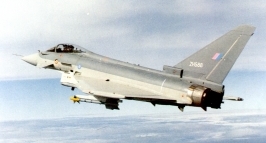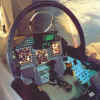 The Eurofighter 2000
is the product of a revised EFA in the light of the termination of the Cold War -
a development that almost saw Germany withdraw from the project. This fighter eventually
made its maiden flight on 27 March l994. It had been preceded by the EAP
Experimental Aircraft Program) which was a proof of concept air- craft that first took to
the air on 8 August 1986.
The Eurofighter 2000
is the product of a revised EFA in the light of the termination of the Cold War -
a development that almost saw Germany withdraw from the project. This fighter eventually
made its maiden flight on 27 March l994. It had been preceded by the EAP
Experimental Aircraft Program) which was a proof of concept air- craft that first took to
the air on 8 August 1986.
A European Staff Requirement for Development of EFA was signed by the four nations (UK, Germany, Italy and Spain) Chiefs of Air Staff in l987. This specified a high performance, agile combat aircraft, optimized for the air superiority role with a comprehensive air-to-surface role. It was expected to exceed the capabilities of existing and future adversaries, and yet maintain a reduced cost of purchase and operating compared with competing aircraft.
The EFA has been designed as an unstable aircraft, which utilizes a highly advanced computer system to retain control, enabling faster response. Pilot control is fed through a quadruple "fly by wire" system into the computer, which then outputs the appropriate signals to the various controls. Much use has been made of carbonfibre materials and other advanced materials to reduce weight yet maintain strength and durability.
Due to its small size, EFA has a small radar cross section, which, together with the use of radar absorbent materials, provides the air- craft with a stealthy radar signature. The aircraft is also fitted with a number of passive sensors, such as the Infra Red Search and Track System IRSTS), which will enable the pilot to launch his attack sequence without using his radar and thereby indicating his presence to an enemy. To assist the pilot, EFA is fitted with the state of the art"glass cock- pit" containing three full color multi-function displays on which all key tactical flight information is presented, plus a Head Up Display (HUD). Pilot control is through a Hands On Throttle And Stick (HOTAS) which replaces the conventional "joystick". The pilot also has a direct voice input system enabling him to operate some procedures by speech. The helmet also has a mounted symbology system which maximizes head up flying for the pilot.
The ECR 90 radar that is fitted to EFA is one of the most advanced systems for the long range detection and acquisition of multiple tar gets. It is highly ECM resistant and incorporates a threat analysis to identify and prioritize targets for the pilot. A Defensive Aids Sub- System provides the pilot with an all-round threat assessment and can make responses automatically or manually.
A total of thirteen hard points give EFA a high load capacity and ability to accept various missile configurations. External fuel tanks can be fitted to three hard points. For the air-to-air role a mixture of at least ten ASRAAMs and AMRAAMs can be accommodated, while seven hard points can be utilized for the ground support role. A multi- role configuration might include six air-to-surface missiles or bombs plus six air-to-air missiles plus external fuel tanks together with an internal gun.
Seven development aircraft have either been or are being built with the various companies responsible for certain major components. The front fuselage and foreplanes by BAe, MBB -centre fuselage and fin, Alenia and CASA - rear fuselage, Alenia - left wing, BAe and CASA right wing. The production workshare will be allocated according to the actual number of aircraft ordered by each nation, with each company having final assembly for that number of aircraft.
SPECIFICATION
Span:34 ft 5,5 in / 10.50 m
Length: 47 ft 7 in / 14.50 m
Height: 13 ft 1,5 in / 4.00 m
Weight: 21,495 lb (9750 kg) empty / 46,297 lb (21000 kg) max. take-off
Armament: One 27 mm Mauser cannon and 13 external store stations.
Engines: Two Eurojet EJ200 each rated at about 13,490 lb st dry and 20,250 lb st
afterburning.
PERFORMANCE
Speed: maximum level speed 'clean' at 36,090 ft (11000 m) 2125 km/h (1,147 kt; 1,321 mph)
Range:combat radius between 463 and 556 km (250 and 300 nm; 288 and 345 miles)
Take-off run:500 m (1,640 ft) at normal take-off weight
Landing-run: 500 m (1,640 ft) at normal landing weight
G-limits:-3 to +9








